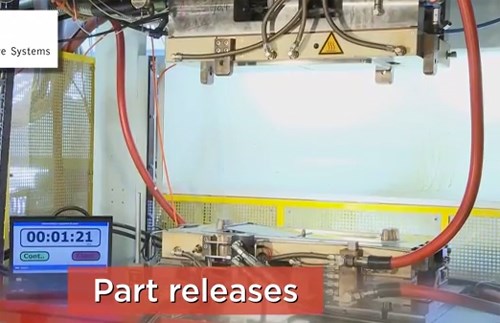Dow epoxy joins the fast-cure race
Dow Automotive made waves at JEC Europe with the debut of VORAFORCE 5300, a low-viscosity, <90-second cure epoxy for automotive composites molding applications.

Dow Automotive (Schwalbach, Germany and Auburn Hills, Mich., USA) made some waves last week when it leapt into the fast-cure epoxy market at JEC Europe 2014 (Paris, France) with the introduction of VORAFORCE 5300. Designed specifically for use in resin transfer molding (RTM), and aimed at the automotive market, the material offers a sub-90-second cycle time and is the latest of many salvos from the resin manufacturing community, which has been working hard to help make composites manufacturing compatible with high-volume automaking.
Dr. Rainer Koeniger, senior R&D manager, Automotive Composites, at Dow Europe GmbH (Freienbach, Germany) and Peter Cate, global strategic marketing manager, Composite Structures, at Dow Automotive Systems (Staines-upon-Thames, U.K.), said at JEC Europe that VORAFORCE 5300’s extremely low viscosity (15 mPa/s) gives the resin good persistent flow throughout the preform and helps reduce press tonnage requirements. They also reported that VORAFORCE 5300 offers mechanical performance on par with other competitive epoxies, and thermal performance of about 120°C/248°F. It also features in internal mold release, thus eliminating external mold release costs.
The above Dow Automotive video proves the cycle time capabilities of the materials. Koeniger and Cate noted that Dow believes a cycle time of about 60 seconds is possible with this resin, and both said specifically that Dow defines cycle time as preform insert to press open. Dow has optimized the resin for use with DowAksa carbon fibers using a KraussMaffei RTM machine, but Koeniger and Cate said it is compatible with all fiber brands and RTM equipment.
They added that Dow believes VORAFORCE 5300 will have good application in parts consolidation, large-part manufacturing and hybrid structures manufacturing.
Related Content
-
Materials & Processes: Fibers for composites
The structural properties of composite materials are derived primarily from the fiber reinforcement. Fiber types, their manufacture, their uses and the end-market applications in which they find most use are described.
-
Protecting EV motors more efficiently
Motors for electric vehicles are expected to benefit from Trelleborg’s thermoplastic composite rotor sleeve design, which advances materials and processes to produce a lightweight, energy-efficient component.
-
Troubleshooting thermal design of composite battery enclosures
Materials, electrical insulation and certification are all important factors to consider when optimizing electric battery performance against potential thermal runaway.













.jpg;maxWidth=300;quality=90)


